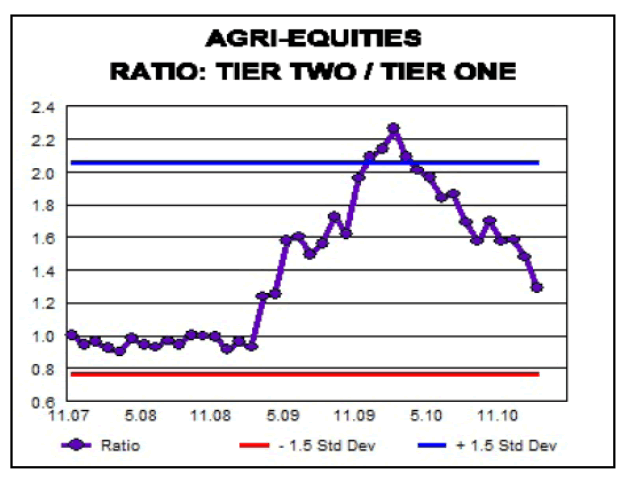Agri-Food's Correct as Silver Stays in Fantasy Debt Fueled Bubble Land
Commodities / Agricultural Commodities Feb 28, 2011 - 04:04 AM GMTBy: Ned_W_Schmidt
 I said, "Scotty, Beam me up." However, the message was apparently garbled, and Scotty apparently beamed me back instead. Since it seems so much like 2008, it must be Scotty's fault. Or, is it possible that Bernanke's Lap Dogs are again distorting asset prices? Surely they must have learned something from making the same mistake over and over. Even a cat learns faster.
I said, "Scotty, Beam me up." However, the message was apparently garbled, and Scotty apparently beamed me back instead. Since it seems so much like 2008, it must be Scotty's fault. Or, is it possible that Bernanke's Lap Dogs are again distorting asset prices? Surely they must have learned something from making the same mistake over and over. Even a cat learns faster.
U.S. equities have now compounded at a 30+% compound rate for more than two years. Is the U.S. economy that much better off? Unemployment has not improved materially. Latest U.S. GDP revision was negative as state and local government spending plunged. Few of the state governments in the U.S. are now financially solvent if the accounting were true.
Yet, the stock markets continue to rise on free money being again provided by the Federal Reserve. Valuations for social networking sites, which produce nothing of economic value, are approaching the nonsense of the last internet bubble. Silver is in fantasy land, brought on by a debt fueled, mania-based rally. How large will be the losses in Silver this coming year? At the same time, commodity prices might be replicating the fund induced mania of 2008.

Urged on by media reports of riots throughout the despot ridden Middle East, traders pushed Agri-Food commodity prices to record highs in recent times. Green line in above chart, using right axis, is our Agri-Food Price Index. Red line, using left axis, is a stochastic built on that price index. As can be observed, that measure has been pegged at over bought for some time.
In 2008 that stochastic was pegged at over bought for an extended period. That era is marked by the blue box on the left. That blue box on the right is the same size as the first one. While the length of time does not yet match that of 2008, it is working on it. While over bought does not make a market go down, it is often an importer precursor of such an event.
Why might Agri-Food prices develop some form of corrective process, and why should investors care? On the latter, the goal is to buy low. A correction in Agri-Food commodity prices should create an opportunity to purchase Agri-Equities at attractive levels. As to the first question, bullishness has recently reached excesses that seem now to be weakening. Commodity prices do not compound, for unlike stocks an economic response does develop from higher prices. Commodity price runs of more than six months have grey hair and painful joints. They rarely develop a second wind.
Agri-Equities have been influenced in an extremely positive manner by the strong move in Agri-Food commodity prices. In particular, Agri-Equity investments have been dominated by large investors with a preference for large capitalization, multi national Agri-Equities. Many such funds could not or do not buy corn, but they sure bought tractor stocks.

In the above chart is plotted the ratio of our index of Tier Two Agri-Equities divided by our index of Tier One Agri-Equities. Tier Two is at this time composed of Chinese Agri-Equities. These companies are directly involved in serving the Agri-Food needs of China. They are small, and their businesses are volatile. Tier One is comprised of large established multinational Agri-Companies, including names like DE and SYT.
If that blue line in the chart is rising, Chinese Agri-Equities are providing superior performance. If the line is declining, as it has been for the last year, the Tier One Agri-Equities are performing better. As is readily apparent, Tier One has ruled for the past year. In the year prior to that, the Chinese Agri-Equities were on top.
In the weeks ahead, this relative performance pattern may begin to shift as it has becomes over extended in one direction. Investors might be better served to read fewer reports on large companies, which are probably efficiently priced at this time, and do more research on Chinese Agri-Equities. While not able to predict which will win the 2011 race, Chinese Agri-Equities have the fundamentals to win the next decade. 1.3 billion people with wallets filling and a desire to eat better are a lot of fundamentals. Emergence of a strain of Jasmine revolt should only strengthen that trend as the government is likely to respond to such pressures as it has in the past. Prosperity is the Chinese governments most effective tool for appeasing the populace.
By Ned W Schmidt CFA, CEBS
AGRI-FOOD THOUGHTS is from Ned W. Schmidt,CFA,CEBS, publisher of The Agri-Food Value View, a monthly exploration of the Agri-Food grand cycle being created by China, India, and Eco-energy. To contract Ned or to learn more, use this link: www.agrifoodvalueview.com.
Copyright © 2010 Ned W. Schmidt - All Rights Reserved
Ned W Schmidt Archive |
© 2005-2022 http://www.MarketOracle.co.uk - The Market Oracle is a FREE Daily Financial Markets Analysis & Forecasting online publication.



